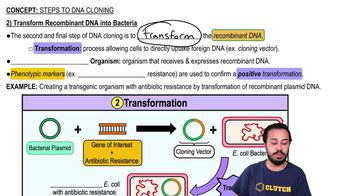Table of contents
- 1. Introduction to Biology2h 42m
- 2. Chemistry3h 40m
- 3. Water1h 26m
- 4. Biomolecules2h 23m
- 5. Cell Components2h 26m
- 6. The Membrane2h 31m
- 7. Energy and Metabolism2h 0m
- 8. Respiration2h 40m
- 9. Photosynthesis2h 49m
- 10. Cell Signaling59m
- 11. Cell Division2h 47m
- 12. Meiosis2h 0m
- 13. Mendelian Genetics4h 44m
- Introduction to Mendel's Experiments7m
- Genotype vs. Phenotype17m
- Punnett Squares13m
- Mendel's Experiments26m
- Mendel's Laws18m
- Monohybrid Crosses19m
- Test Crosses14m
- Dihybrid Crosses20m
- Punnett Square Probability26m
- Incomplete Dominance vs. Codominance20m
- Epistasis7m
- Non-Mendelian Genetics12m
- Pedigrees6m
- Autosomal Inheritance21m
- Sex-Linked Inheritance43m
- X-Inactivation9m
- 14. DNA Synthesis2h 27m
- 15. Gene Expression3h 20m
- 16. Regulation of Expression3h 31m
- Introduction to Regulation of Gene Expression13m
- Prokaryotic Gene Regulation via Operons27m
- The Lac Operon21m
- Glucose's Impact on Lac Operon25m
- The Trp Operon20m
- Review of the Lac Operon & Trp Operon11m
- Introduction to Eukaryotic Gene Regulation9m
- Eukaryotic Chromatin Modifications16m
- Eukaryotic Transcriptional Control22m
- Eukaryotic Post-Transcriptional Regulation28m
- Eukaryotic Post-Translational Regulation13m
- 17. Viruses37m
- 18. Biotechnology2h 58m
- 19. Genomics17m
- 20. Development1h 5m
- 21. Evolution3h 1m
- 22. Evolution of Populations3h 52m
- 23. Speciation1h 37m
- 24. History of Life on Earth2h 6m
- 25. Phylogeny2h 31m
- 26. Prokaryotes4h 59m
- 27. Protists1h 12m
- 28. Plants1h 22m
- 29. Fungi36m
- 30. Overview of Animals34m
- 31. Invertebrates1h 2m
- 32. Vertebrates50m
- 33. Plant Anatomy1h 3m
- 34. Vascular Plant Transport1h 2m
- 35. Soil37m
- 36. Plant Reproduction47m
- 37. Plant Sensation and Response1h 9m
- 38. Animal Form and Function1h 19m
- 39. Digestive System1h 10m
- 40. Circulatory System1h 57m
- 41. Immune System1h 12m
- 42. Osmoregulation and Excretion50m
- 43. Endocrine System1h 4m
- 44. Animal Reproduction1h 2m
- 45. Nervous System1h 55m
- 46. Sensory Systems46m
- 47. Muscle Systems23m
- 48. Ecology3h 11m
- Introduction to Ecology20m
- Biogeography14m
- Earth's Climate Patterns50m
- Introduction to Terrestrial Biomes10m
- Terrestrial Biomes: Near Equator13m
- Terrestrial Biomes: Temperate Regions10m
- Terrestrial Biomes: Northern Regions15m
- Introduction to Aquatic Biomes27m
- Freshwater Aquatic Biomes14m
- Marine Aquatic Biomes13m
- 49. Animal Behavior28m
- 50. Population Ecology3h 41m
- Introduction to Population Ecology28m
- Population Sampling Methods23m
- Life History12m
- Population Demography17m
- Factors Limiting Population Growth14m
- Introduction to Population Growth Models22m
- Linear Population Growth6m
- Exponential Population Growth29m
- Logistic Population Growth32m
- r/K Selection10m
- The Human Population22m
- 51. Community Ecology2h 46m
- Introduction to Community Ecology2m
- Introduction to Community Interactions9m
- Community Interactions: Competition (-/-)38m
- Community Interactions: Exploitation (+/-)23m
- Community Interactions: Mutualism (+/+) & Commensalism (+/0)9m
- Community Structure35m
- Community Dynamics26m
- Geographic Impact on Communities21m
- 52. Ecosystems2h 36m
- 53. Conservation Biology24m
26. Prokaryotes
Prokaryotic Diversity
Problem 6`
Textbook Question
Plantlike photosynthesis that releases O2 occurs in
a. Cyanobacteria
b. Archaea
c. Gram-positive bacteria
d. Chemoautotrophic bacteria
 Verified step by step guidance
Verified step by step guidance1
Understand the process of photosynthesis: Photosynthesis is the process by which green plants, algae, and certain bacteria convert light energy into chemical energy, producing oxygen (O2) as a byproduct.
Identify the organisms capable of photosynthesis: Among the options given, cyanobacteria are known for their ability to perform plantlike photosynthesis, releasing oxygen.
Differentiate between the types of bacteria: Cyanobacteria are a type of bacteria that contain chlorophyll and perform photosynthesis similar to plants. Archaea, gram-positive bacteria, and chemoautotrophic bacteria do not perform photosynthesis that releases oxygen.
Recognize the role of cyanobacteria: Cyanobacteria are often referred to as blue-green algae and are significant contributors to oxygen production in aquatic environments.
Conclude which organism performs plantlike photosynthesis: Based on the characteristics of cyanobacteria, they are the correct answer for the organism that performs plantlike photosynthesis releasing O2.
 Verified video answer for a similar problem:
Verified video answer for a similar problem:This video solution was recommended by our tutors as helpful for the problem above
Video duration:
1mPlay a video:
Was this helpful?
Key Concepts
Here are the essential concepts you must grasp in order to answer the question correctly.
Photosynthesis
Photosynthesis is the process by which green plants, algae, and some bacteria convert light energy into chemical energy, producing oxygen as a byproduct. It involves the absorption of light by chlorophyll and the conversion of carbon dioxide and water into glucose and oxygen. This process is crucial for the survival of most life forms on Earth as it provides oxygen and organic compounds.
Recommended video:
Guided course

Pigments of Photosynthesis
Cyanobacteria
Cyanobacteria, also known as blue-green algae, are a group of photosynthetic bacteria that perform plantlike photosynthesis, releasing oxygen. They are significant contributors to the Earth's oxygen supply and are found in diverse environments, from oceans to freshwater systems. Cyanobacteria possess chlorophyll and use sunlight to convert carbon dioxide and water into glucose and oxygen, similar to plants.
Recommended video:
Guided course

Prokaryote Lineages 2
Chemoautotrophic Bacteria
Chemoautotrophic bacteria obtain energy by oxidizing inorganic substances, such as hydrogen sulfide or ammonia, rather than through photosynthesis. They do not release oxygen as a byproduct because their energy conversion process does not involve the splitting of water molecules. These bacteria play a vital role in nutrient cycling, particularly in environments where sunlight is scarce, such as deep-sea vents.
Recommended video:
Guided course

2) Transform Recombinant DNA into Bacteria
Related Videos
Related Practice












